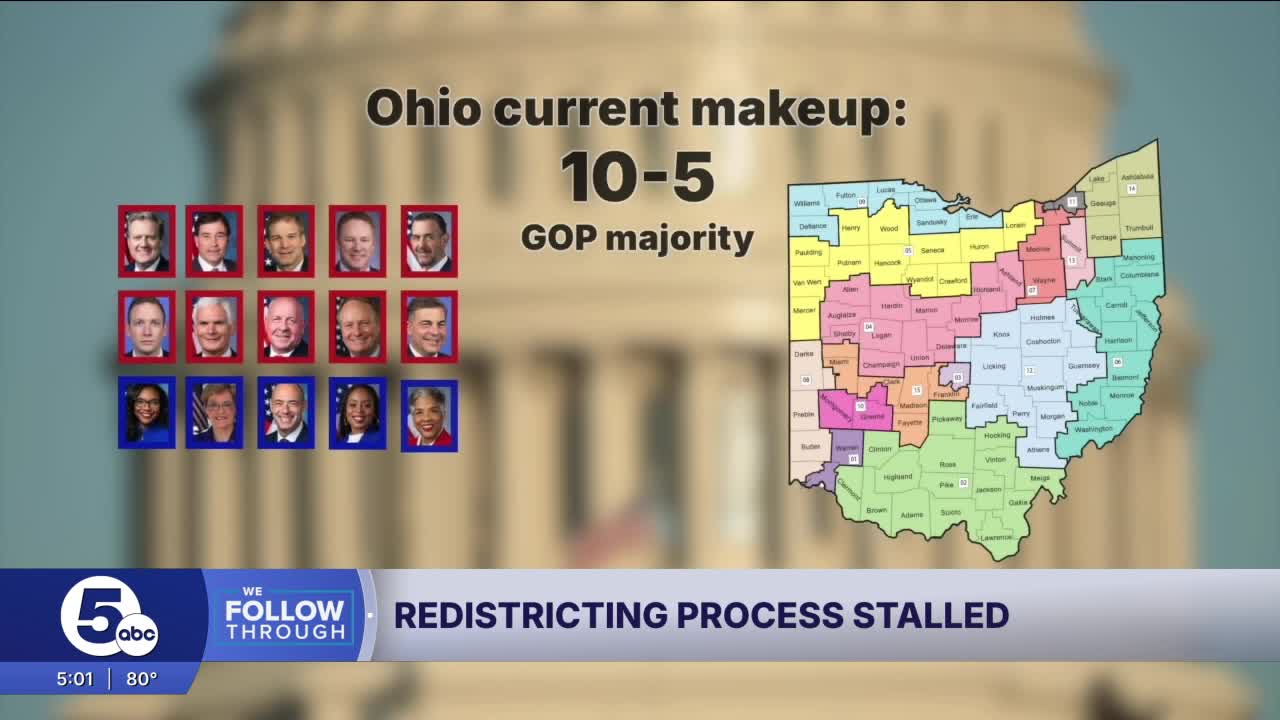COLUMBUS, Ohio — As members of Congress cause a government shutdown, Ohio has a stalemate of its own. Lawmakers missed their redistricting deadline, and with no future meeting set, targeted Democrats worry about fair representation on the national stage.
It's day three of the federal government being shut down, with no possible end until next week.
"You have one party in power, they're refusing to come to the table, they're refusing to talk with Democrats," Democratic U.S. Rep. Emilia Sykes (OH-13) said in an interview Thursday.
Ohio’s congressional redistricting process is also stalling — with Sykes saying it's for the same reason.
"I'd say, Morgan, this is a failure of leadership," she told me.
On Sept. 30, lawmakers missed their deadline of passing a bipartisan map to redraw Ohio’s 15 U.S. House seats. The Democrats turned in their proposed district map to debate, while the Republicans did not submit one.
"Whatever it is that we're going to do, the public needs to weigh in on it, but they also need to weigh on it before there's a map," House Speaker Matt Huffman (R-Lima) said Wednesday.
Democrats like Senate Minority Leader Nickie Antonio (D-Lakewood) believe that the Republicans purposely dragged their feet on making a map to delay this process so that they can push through a map of their choosing at the end.
On average, Republicans win 55% to 45% over Democrats. With that breakdown, Democrats proposed a map with eight seats leaning red and seven leaning blue. However, Ohio's 15 congressional districts are currently composed of 10 Republicans and five Democrats.
Republicans like U.S. Senator Bernie Moreno say that makeup should change.
"I think we're going to end up with 13 and 2," Moreno said during an interview this summer. "I think we're going to end up with 13 Republicans representing Ohio in the House of Representatives."
This is fair, he said, since Democrats are primarily in cities. Including them in rural districts would dilute the conservative representation, he said.
"Look at the physical map of Ohio and compare the red versus the blue, and most of the state is red," Moreno said.
This argument is the crux of the debate going on at the Statehouse, where Democrats argue back that land doesn't vote. They also pointed out that Moreno only won against longtime Democratic Senator Sherrod Brown 50-46% in 2024.
To gain three seats, Moreno signals who the party is targeting.
"The days are numbered for Emilia Sykes," the senator said.
Elected first in 2023, the Akron Democrat represents District 13, which is all of Summit County, most of Stark and a slim part of Portage. This also won't be the first time her seat has faced the GOP's gaze.
RELATED: Ohio GOP eyes U.S. Rep. Emilia Sykes’ seat as congressional redistricting begins
In a close race during the 2024 cycle, Sykes beat former state lawmaker Kevin Coughlin 51.11-48.89%.
Reps. Marcy Kaptur of District 9 in Northwest Ohio and Greg Landsman of District 1 in Southwest Ohio are also at risk. Both have spoken out for years against partisan gerrymandering.
Kaptur narrowly beat former state lawmaker Derek Merrin 48.27-47.63% in 2024. That same year, Landsman beat lawyer Orlando Sonza 54-45%.
I asked U.S. Sen. Jon Husted if he thought 12-3 or 13-2 were reflective of the voting population. He didn’t answer that, but reminded that when he was House Speaker in 2006, he worked on a deal with the Democrats to prevent future gerrymandering, but they backed out.
"I have no sympathy for them in that respect because they caused this problem," Husted said.
After Husted's attempt, voters passed reform efforts in both 2015 and 2018 to stop gerrymandering. Democrats say the GOP refuses to listen.
Learn more about the Redistricting issues of 2022 and the attempt to change who is in charge of mapmaking in 2024, one that failed.
For Sykes, she said that voters chose her and that drawing unfair maps elects people into office who don't want to work together.
"People want folks who will go in, roll up their sleeves and get to work and you often don't get that when you have extreme members of either side in governing bodies," she said.
Now, the GOP-controlled Ohio redistricting commission will need to pass a map by the end of October. The ORC is made up of seven spots. Two will always go to Republicans and two to Democrats in the Statehouse. The three remaining seats include the governor, secretary of state and auditor.
Democrats, who have found an ally in Republican Gov. Mike DeWine on many issues, including vaccines, LGBTQ+ rights and education, have reached out to him in an effort to team up to stop gerrymandering and convene the ORC as soon as possible.
"While we do not always agree on policy, Ohioans of all stripes know that, as Governor, you care for the whole state. At times of great crisis, we have all witnessed your leadership as you put politics aside," Antonio and House Minority Leader Dani Isaacsohn (D-Cincinnati) wrote in a letter delivered this week. "With ever increasing partisan fights sweeping the country from Texas to Missouri to California, we ask for your partnership in moving Ohio in a different direction as we work together."
Deadlines and process
FAILED: Sept. 30: The lawmakers need to pass a map with at least 60% in each chamber, with at least 50% support of Democrats.
Oct. 31: To meet this deadline, at least four members of the ORC, including two Republicans and two Democrats, must approve.
If that fails, it goes back to the legislature.
Nov. 30: This map can also pass with a simple majority, and it must be replaced after six years.
RELATED: Ohio House Speaker says he won’t let Trump pressure him during redistricting process
Follow WEWS statehouse reporter Morgan Trau on Twitter and Facebook.






